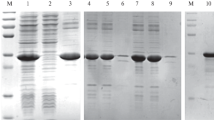Abstract
Two strains of Histoplasma capsulatum were required to prepare maximum yields of H and of M antigen from histoplasmin. The antigens were separated and partially purified by a series of procedures yielding an overall recovery of 70 to 90% of the individual antigens. Stable products suitable for use as reference products were obtained when the final purification step employed DEAE-cellulose with phosphate buffer elution at increasing molarity and decreasing pH. A final step of purification of each antigen with slab acrylamide gel electrophoresis gave products which were highly reactive and specific in a variety of serological tests with sera from persons with proven cases of histoplasmosis and with natural infections of heterologous deep mycoses. These antigens were maximally active at concentrations of 2 to 16 μg protein in the complement fixation, capillary precipitin, microimmunodiffusion, or immunoelectrophoresis tests; 0.5 μg gave a maximum delayed cutaneous hypersensitivity reaction in homologously infected animals and caused no appreciable reaction in control animals. Although these antigens appeared to be specific when tested with sera from persons with natural infections, the M and H antigens demonstrated the presence of an additional antigen reacting with sera of rabbits immunized with cell membrane and cell particulate fractions of Blastomyces dermatitidis. After purification by electrophoresis, both the H and M antigens of some preparations showed some decomposition and loss of reactivity after storage at 5 C for more than six months. The overall results suggest that the purified H and M antigens of Heiner (12) have multiple serological reactivity and may function in precipitin reactions, complementfixing reactions, hemagglutination of formalin-fixed goose red blood cells, and as antigens for delayed cutaneous tests.
Similar content being viewed by others
References
Bartels, P. A. 1971. Partial chemical characterization of histoplasmin H-42. pp. 56–63. In: L. Ajello, E. W. Chick & M. L. Furcolow (eds), Histoplasmosis. Proceedings of the Second National Conference. Charles C. Thomas, Springfield.
Bradley, G., L. Pine, M. W. Reeves & C. W. Moss. 1974. Purification, composition, and serological characterization of histoplasmin-H and M antigens. Infect. Immun. 9: 870–880.
Cann, J. R. 1968. Recent advances in the theory and practice of electrophoresis. Immunochemistry 5: 107–134.
Cohen, J. O. & L. Pine. 1968. Quantitative aspects of the M protein capillary precipitin test. Appl. Microbiol. 16: 122–127.
Dickerson, W. H., Jr. & J. F. Busey. 1968. Chromatographic separation of h and m antigens from histoplasmin. Proc. Soc. Exp. Biol. Med. 128: 654–658.
Dubois, M. K., A. Gilles, J. K. Hamilton, P. A. Rebers & F. Smith. 1956. Colorimetric method for determination of sugars and related substances. Anal. Chem. 28: 350–356.
Ehrhard, H.-B. & L. Pine. 1972. Factors influencing the production of H and M antigens by Histoplasma capsulatum: development and evaluation of a shake culture procedure. Appl. Microbiol. 23: 236–249.
Gehrke, C. W., H. Nakamoto & R. W. Zumwalt. 1969. Gas-liquid chromatography of protein amino acids trimethylsilyl derivative. J. Chromatogr. 45: 24–51.
Green, J. H., W. K. Harrell, S. B. Gray, J. E. Johnson, R. C. Bolin, H. Gross & G. B. Malcolm. 1976. H and M antigens of Histoplasma capsulatum: Preparation of antisera and location of these antigens in yeast-phase cells. Infect. Immun. 14: 826–831.
Greene, C. H., L. S. DeLalla & V. N. Tompkins. 1960. Separation of specific antigens of Histoplasma capsulatum by ion exchange chromatography. Proc. Soc. Exp. Biol. 105: 140–141.
Gross, H., G. Bradley, L. Pine, S. Gray, J. H. Greene & W. K. Harrell. 1975. Evaluation of histoplasmin for presence of H and M antigens: some difficulties encountered in the production and evaluation of a product suitable for the immunodiffusion test. J. Clin. Microbiol. 1: 330–334.
Heiner, D. C. 1958. Diagnosis of histoplasmosis using precipitin reactions in agar gel. Pediatrics 22: 616–627.
Howell, A. 1947. Studies of fungus antigens. I. Quantitative studies of cross-reactions between histoplasmin and blastomycin in guinea pigs. Public Health Rep. 62: 631–651.
Lowry, O. H., N. A. Rosebrough, A. L. Farr & R. J. Randall. 1951. Protein measurement with the Folin phenol reagent. J. Biol. Chem. 193: 265–275.
Moss, C. W. & M. A. Lambert. 1971. Gas-liquid chromatography of twenty protein amino acids on a single column. J. Chromatogr. 60: 134–136.
Neter, E. 1956. Bacterial hemagglutination and hemolysis. Bact. Rev. 20: 166–188.
Ornstein, L. 1964. Disc electrophoresis-1. Background and theory. Ann. New York Acad. Sci. 121: 321–349.
Pine, L. 1970. Growth of Histoplasma capsulatum. VI. Maintenance of the mycelial phase. Appl. Microbiol. 19: 413–420.
Pine, L., R. G. Falcone & C. J. Boone. 1969. Effect of thimerosal on whole yeast phase antigen of Histoplasma capsulatum. Mycopathol. Mycol. Appl. 37: 1–14.
Reeves, M., L. Pine & G. Bradley. 1974. Characterization and evaluation of a soluble antigen complex prepared from the yeast phase of Histoplasma capsulatum. Infect. Immun. 9: 1033–1044.
Reiss, E., W. O. Mitchell, S. H. Stone & H. F. Hasenclever. 1974. Cellular immune activity of a galactomannan-protein complex from mycelia of Histoplasma capsulatum. Infect. Immun. 10: 802–809
Smith, C. E., E. G. Whiting, E. E. Baker, H. G. Rosenberger, R. R. Beard & M. T. Saito. 1948. The use of coccidioidin. Amer. Rev. Tuberc. 57: 330–360.
Standard, P. G. & L. Kaufman. 1976. A specific immunological test for the rapid identification of members of the genus Histoplasma. J. Clin. Microbiol. 3: 191–199.
Wadsworth, C. 1957. A slide microtechnique for the analysis of immune precipitate in gel. Intern. Arch. Allergy Appl. Immunology 10: 355–360.
Wiggens, G. L. & J. H. Schubert. 1965. Relationship of histoplasmin agar-gel bands and complement fixation titers in histoplasmosis. J. Bacteriol. 89: 589–596.
Author information
Authors and Affiliations
Rights and permissions
About this article
Cite this article
Pine, L., Gross, H., Malcolm, G.B. et al. Procedures for the production and separation of H and M antigens in histoplasmin: Chemical and serological properties of the isolated products. Mycopathologia 61, 131–141 (1977). https://doi.org/10.1007/BF00468007
Issue Date:
DOI: https://doi.org/10.1007/BF00468007




